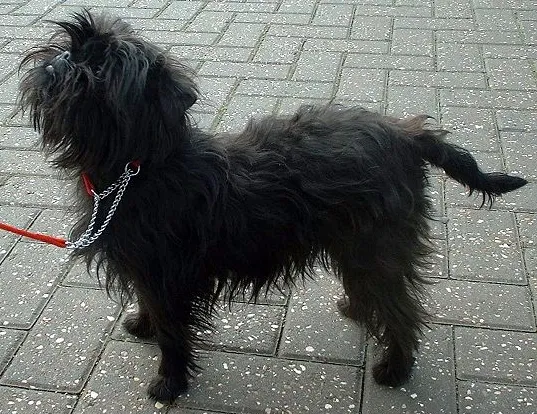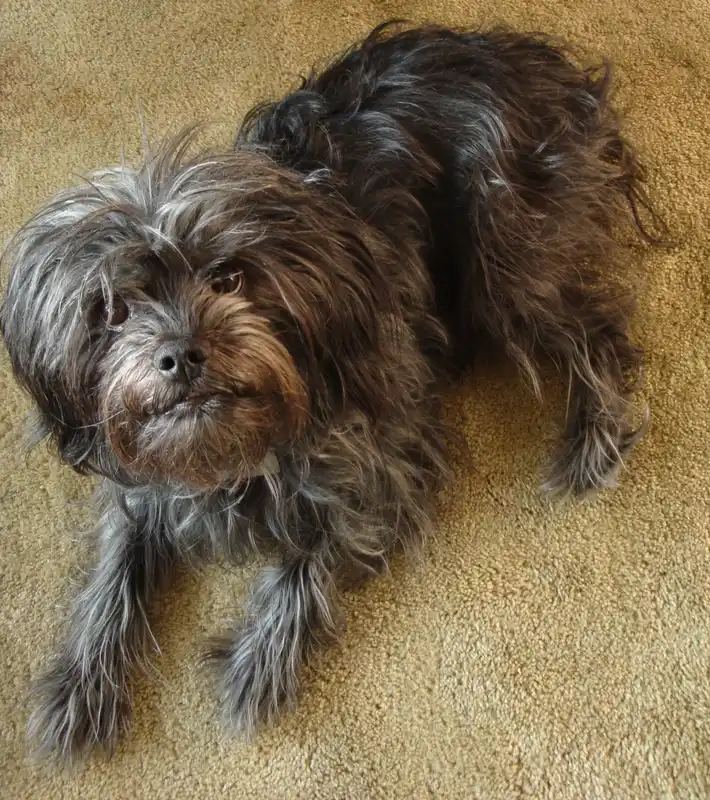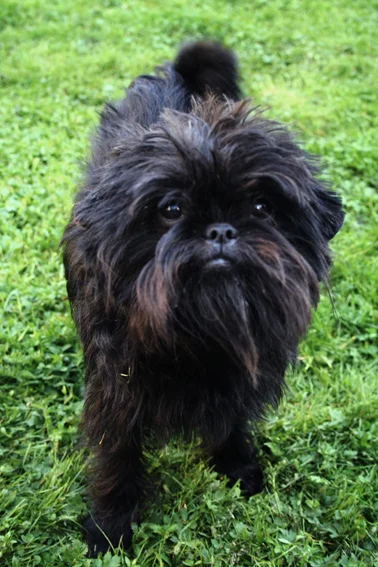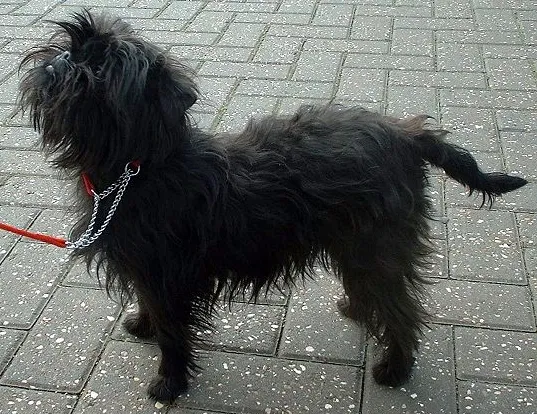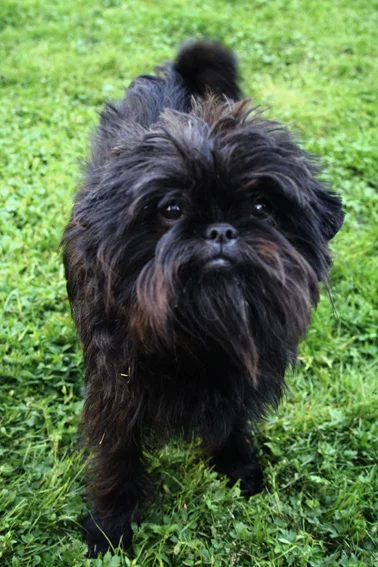Affenpinscher
The Affenpinscher is a small, playful breed known for its monkey-like appearance and lively personality. Originating from Germany, they make excellent companions and are great for families.
Overview
🐕Breed Overview
The Affenpinscher, often referred to as the 'monkey terrier,' is a small, lively breed known for its distinctive appearance and playful personality. Originating from Germany in the 1600s, this breed was initially bred for vermin control, making it a valuable companion on farms. With a height ranging from 9 to 12 inches and a weight of 7 to 9 pounds, the Affenpinscher is compact and sturdy, featuring a wiry coat that adds to its unique charm.
Their playful and mischievous nature makes them excellent companions for families, although they do best with older children due to their small size. Affenpinschers are known for their intelligence and can be trained effectively with positive reinforcement methods. They thrive on social interaction and require regular exercise to keep them happy and healthy.
With an average lifespan of 12 to 14 years, these dogs are not only entertaining but also loyal companions that bring joy to any household. Their adaptability allows them to live comfortably in various environments, from apartments to larger homes, as long as they receive adequate exercise and mental stimulation. Overall, the Affenpinscher is a delightful breed that combines a playful spirit with a loving nature, making them a cherished addition to any family.
Breed Characteristics
Family & Friends
Good Behavior
Get Up & Go
Household Harmony
Temperament & Personality
✨Key Traits
🐕Core Temperament
The Affenpinscher is characterized by its inquisitive and bold temperament. They are playful and affectionate with their families, often seeking attention and interaction.
While they can be stubborn and independent, they respond well to positive reinforcement training methods. Affenpinschers are generally good with other pets, although they may exhibit territorial behaviors.
Their fearless nature makes them protective of their home and family, and they will bark to alert their owners of any perceived threats. Overall, they are lively companions that thrive on social interaction and mental stimulation.
💫Personality Profile
Affenpinschers are known for their lively and playful personalities. They are affectionate towards their families and enjoy being involved in daily activities.
Their curious nature often leads them to explore their surroundings, and they can be quite mischievous. While they are generally good with other pets, they may exhibit territorial behaviors, particularly around their toys and food.
Affenpinschers are alert and can be vocal, making them effective watchdogs. They thrive on social interaction and require consistent training to manage their stubborn streak.
🔊Vocal Tendencies
Affenpinschers are generally quiet dogs but can become vocal when they perceive a threat or are excited. They may bark to alert their owners of strangers or when playing.
Their barking tendency is moderate, and while they are not excessive barkers, they do enjoy expressing themselves, especially during playtime. Their vocalizations can range from barks to playful yips, reflecting their energetic and spirited nature.
Affection & Social Traits
Energy & Activity
Communication Style
Care Requirements
🏃♂️Exercise Requirements
Daily Exercise
The Affenpinscher requires a moderate amount of exercise to maintain its health and happiness. Ideally, they should engage in at least 30 to 60 minutes of physical activity each day. This can include short walks, playtime in the yard, or indoor games that stimulate their playful nature.
Given their small size, they can get sufficient exercise through vigorous indoor play, such as fetch or tug-of-war, as well as outdoor activities like chasing after toys. Puppies may require shorter bursts of activity, while older dogs may enjoy gentler walks. Regular exercise is crucial for preventing obesity and promoting good mental health, as Affenpinschers are known to be energetic and curious.
Insufficient exercise can lead to boredom, which may result in destructive behaviors or excessive barking.
🏠Living & Adaptability
Space Requirements
Affenpinschers are adaptable to various living environments, making them suitable for both apartments and houses. They thrive in spaces where they can interact with their owners and have room to play.
While they can live comfortably in smaller spaces, it is essential to provide them with regular opportunities for exercise and mental stimulation. Owners in apartments should ensure that their Affenpinscher receives daily walks and playtime to prevent boredom and anxiety.
Their small size allows them to be easily transported, making them great companions for those who enjoy outdoor activities or travel.
Climate Preference
🍲Feeding Guide
Schedule
Food Types
Portion Size
Special Nutritional Needs
Affenpinschers do not have specific dietary restrictions, but it is essential to provide a balanced diet rich in protein and healthy fats to support their energy levels. Monitor their weight closely, as small breeds can be prone to obesity. Regular vet check-ups can help assess their nutritional needs and adjust their diet accordingly.
✨Grooming Requirements
Grooming Overview
The Affenpinscher's wiry coat requires regular grooming to keep it healthy and free of mats. Owners should brush their dog's coat two to three times a week to remove loose hair and prevent tangles.
Regular grooming helps maintain the breed's signature shaggy appearance while keeping their skin healthy. Bathing should be done as needed, typically every few months, or when they become particularly dirty.
For show dogs, professional grooming may be necessary to maintain the coat's texture and appearance. Nail trimming should be done regularly to prevent overgrowth, and dental care is essential to maintain oral health.
Care Schedule
Brush 2-3 times a week; bathe as needed (every few months); trim nails every 2-4 weeks.
Health Profile
⚕️Health Care
Regular veterinary care is crucial for the Affenpinscher's lifespan. Routine check-ups, vaccinations, and preventive treatments can help detect health issues early and ensure the dog remains healthy throughout its life.
Dental care is particularly important for small breeds, as they are prone to dental problems. Maintaining a consistent healthcare routine, including parasite prevention and weight management, can significantly impact the dog's longevity and quality of life.
⏳Average Lifespan
Genetic Factors
Genetics play a significant role in the Affenpinscher's lifespan, with hereditary health issues impacting their overall health. Responsible breeding practices that prioritize genetic diversity can help reduce the risk of inherited conditions.
Potential owners should seek reputable breeders who conduct health testing on their breeding stock to minimize the likelihood of genetic disorders. Understanding the breed's genetic predispositions can help owners make informed decisions about their dog's health and care.
Living Conditions
The Affenpinscher's lifespan can be influenced by various environmental factors, including living conditions, exercise levels, and social interactions. Dogs that receive regular exercise and mental stimulation tend to live longer, healthier lives.
A stable and loving home environment, free from stress, also contributes positively to their overall well-being. Additionally, exposure to extreme temperatures should be avoided, as Affenpinschers are sensitive to both heat and cold.
Providing a comfortable living space with access to fresh air and companionship can enhance their quality of life and longevity.
Training
🧠Intelligence & Trainability
💪Work Drive
Affenpinschers have a moderate work drive, stemming from their history as vermin hunters. They enjoy tasks that challenge their intelligence and keep them active.
Activities such as agility training, obedience competitions, and interactive play can help satisfy their need for mental stimulation. Providing them with toys that require problem-solving skills can also keep them engaged.
It's essential to balance their playtime with structured activities to prevent boredom and maintain their overall well-being.
⚠️Training Considerations
Affenpinschers can be somewhat stubborn and independent, which may pose challenges during training. Their terrier-like personality means they can become easily bored, so training sessions should be varied and engaging.
Consistent, positive reinforcement methods work best for this breed. Socialization is crucial from a young age to help them become well-adjusted adults.
They may exhibit territorial behaviors, particularly around their toys and food, so teaching them to share and interact positively with other pets is essential. Owners should be prepared for occasional barking, especially if they perceive a threat.
📝Training Tips
Training an Affenpinscher requires patience and consistency. Start with basic commands and gradually introduce more complex tasks. Use positive reinforcement techniques, such as treats and praise, to encourage desired behaviors.
Keep training sessions short and fun to maintain their interest. Socialization with other dogs and people is vital to prevent shyness or aggression. Crate training can be beneficial for housebreaking, as Affenpinschers may take longer to learn this skill.
Engaging in interactive games and puzzle toys can also help stimulate their minds and reinforce training.
History & Heritage
📜Origin Story
The Affenpinscher's origins are somewhat obscure, but evidence suggests that small terrier-type dogs resembling them existed in Germany as early as the 15th century. These dogs were primarily kept on farms to control rodent populations.
As the breed evolved, smaller versions became popular as lapdogs for women, capable of entertaining their owners while also serving a practical purpose. The breed's name, translating to 'monkey terrier,' reflects its playful and cheeky nature.
The Affenpinscher's unique appearance and personality have made it a favorite among dog lovers, and it has been featured in various artworks, including paintings by renowned artists like Pierre-Auguste Renoir. Despite its rarity today, the Affenpinscher remains a beloved companion breed.
⏳Development History
The Affenpinscher is one of the oldest toy breeds, believed to have originated in Germany in the 1600s. Initially bred as a ratter, they were used to control vermin in homes and stables.
Over time, they were refined through selective breeding, which included crosses with the pug and German pinscher. This breed's unique appearance, characterized by its monkey-like face and wiry coat, has remained consistent throughout its history.
The Affenpinscher was recognized by the American Kennel Club (AKC) in 1936, although its popularity has fluctuated over the years. Today, they are cherished as companion animals and continue to participate in various dog sports and shows.
🛡️Purpose & Historical Role
Originally bred for vermin control, the Affenpinscher served a dual purpose as both a working dog and a companion. Their small size made them ideal for hunting rodents in homes and stables, while their playful and affectionate nature endeared them to families.
Over the years, they have transitioned primarily into companion animals, known for their lively antics and loyalty. The breed's ability to adapt to various roles, from watchdog to family pet, showcases its versatility and charm.
🏺Cultural Significance
The Affenpinscher has a rich cultural history, often depicted in art and literature. Known as the 'monkey-like terrier' in German, this breed has charmed many with its unique appearance and playful personality.
In France, they are affectionately referred to as 'diablotin moustachu,' meaning 'moustached little devil,' highlighting their mischievous nature. Historically, they were favored by nobility as lapdogs and were also valued for their ability to control vermin in homes and stables.
Their quirky demeanor and distinctive looks have made them a beloved breed in various cultures, and they continue to be celebrated in dog shows and competitions.
Conservation Status
This breed is rare and not commonly found outside its region of origin.
